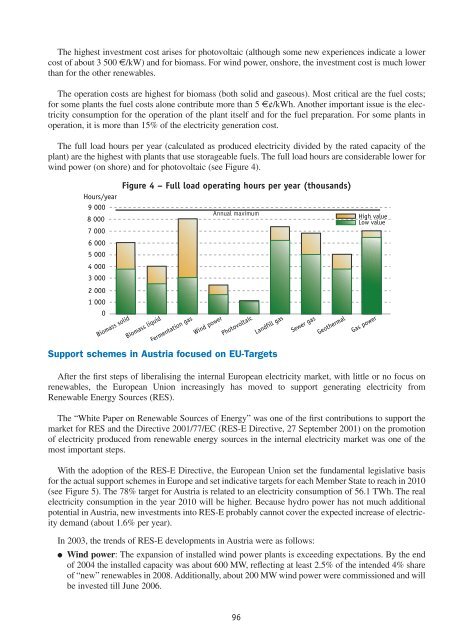Projected Costs of Generating Electricity - OECD Nuclear Energy ...
Projected Costs of Generating Electricity - OECD Nuclear Energy ...
Projected Costs of Generating Electricity - OECD Nuclear Energy ...
Create successful ePaper yourself
Turn your PDF publications into a flip-book with our unique Google optimized e-Paper software.
The highest investment cost arises for photovoltaic (although some new experiences indicate a lower<br />
cost <strong>of</strong> about 3 500 €/kW) and for biomass. For wind power, onshore, the investment cost is much lower<br />
than for the other renewables.<br />
The operation costs are highest for biomass (both solid and gaseous). Most critical are the fuel costs;<br />
for some plants the fuel costs alone contribute more than 5 €¢/kWh. Another important issue is the electricity<br />
consumption for the operation <strong>of</strong> the plant itself and for the fuel preparation. For some plants in<br />
operation, it is more than 15% <strong>of</strong> the electricity generation cost.<br />
The full load hours per year (calculated as produced electricity divided by the rated capacity <strong>of</strong> the<br />
plant) are the highest with plants that use storageable fuels. The full load hours are considerable lower for<br />
wind power (on shore) and for photovoltaic (see Figure 4).<br />
Hours/year<br />
9 000<br />
8 000<br />
7 000<br />
6 000<br />
5 000<br />
4 000<br />
3 000<br />
2 000<br />
1 000<br />
0<br />
Biomass solid<br />
Figure 4 – Full load operating hours per year (thousands)<br />
Biomass liquid<br />
Fermentation gas<br />
Wind power<br />
Annual maximum<br />
Photovoltaic<br />
Landfill gas<br />
Support schemes in Austria focused on EU-Targets<br />
Sewer gas<br />
Geothermal<br />
High value<br />
Low value<br />
Gas power<br />
After the first steps <strong>of</strong> liberalising the internal European electricity market, with little or no focus on<br />
renewables, the European Union increasingly has moved to support generating electricity from<br />
Renewable <strong>Energy</strong> Sources (RES).<br />
The “White Paper on Renewable Sources <strong>of</strong> <strong>Energy</strong>” was one <strong>of</strong> the first contributions to support the<br />
market for RES and the Directive 2001/77/EC (RES-E Directive, 27 September 2001) on the promotion<br />
<strong>of</strong> electricity produced from renewable energy sources in the internal electricity market was one <strong>of</strong> the<br />
most important steps.<br />
With the adoption <strong>of</strong> the RES-E Directive, the European Union set the fundamental legislative basis<br />
for the actual support schemes in Europe and set indicative targets for each Member State to reach in 2010<br />
(see Figure 5). The 78% target for Austria is related to an electricity consumption <strong>of</strong> 56.1 TWh. The real<br />
electricity consumption in the year 2010 will be higher. Because hydro power has not much additional<br />
potential in Austria, new investments into RES-E probably cannot cover the expected increase <strong>of</strong> electricity<br />
demand (about 1.6% per year).<br />
In 2003, the trends <strong>of</strong> RES-E developments in Austria were as follows:<br />
● Wind power: The expansion <strong>of</strong> installed wind power plants is exceeding expectations. By the end<br />
<strong>of</strong> 2004 the installed capacity was about 600 MW, reflecting at least 2.5% <strong>of</strong> the intended 4% share<br />
<strong>of</strong> “new” renewables in 2008. Additionally, about 200 MW wind power were commissioned and will<br />
be invested till June 2006.<br />
96

















